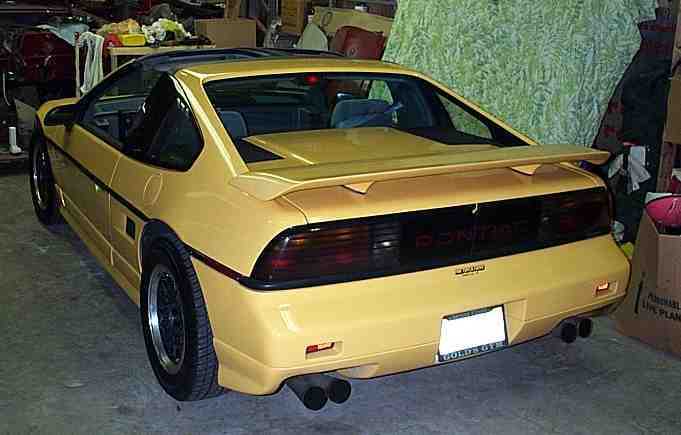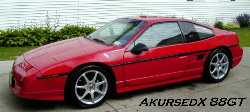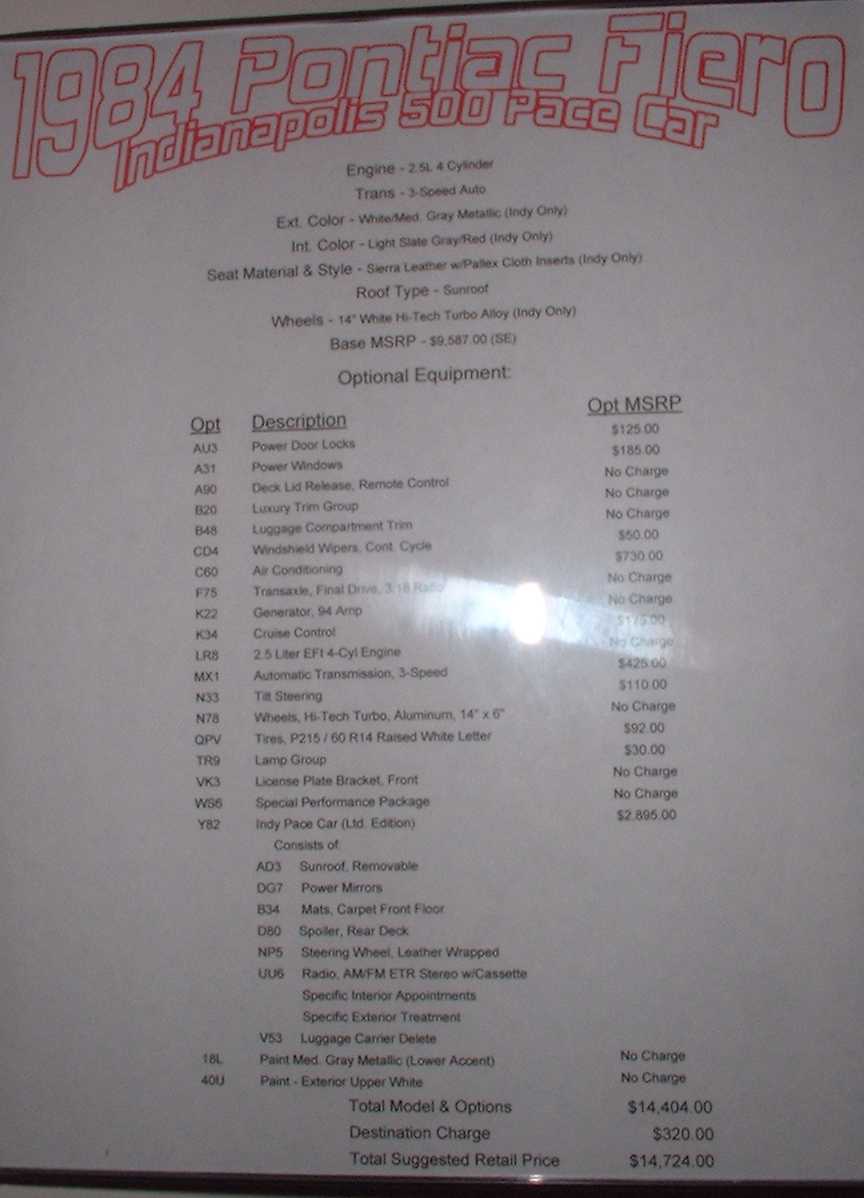Here are some that you know, some you don't know, and some quotes from sources within GM and the auto industry that include facts you may/may not know. Enjoy!
FIERO FACTS
As the Fiero story unfolds, you'll see the logic of everything we did. There are no gimmicks .... technology wrapped in Fiero is absolutely the highest in General Motors .... - J.J. Wetzel, Pontiac Chief Engineer"
Pontiac had been wanting to build a rival to Chevy's sports car for almost 20 years. Although it was designed at first as a commuter car, Pontiac engineers had high hopes of one day making it a true competitor to the Corvette. - Sports Cars of the World, Beekman House books"
We got the car and our assignment was to take this philosophy, this P-car chassis, and to make it a Pontiac - make it a recognizable Pontiac, so that down the road, you'd know it's no other car. - John Schinella, head of the Pontiac Exterior II studio"
If there's any way to wrap up in one word what Pontiac has proved with the Fiero, it has to be 'savvy'. They've proved that somewhere on its engineering staff are men who know what a real, honest sports car is meant to do for its driver. - Phil Hill, veteran race car driver"
Entering 1984, the division hoped to build 95,000 Fieros and 50,000 Parisiennes. Both goals were exceeded by 5,000 units. The market was rebounding and the Fiero put U.S. workers on overtime. - 75 Years of Pontiac, The Official History"
It has been developed on the leading edge of technology ... and from the standpoints of both design and engineering we feel this is the most innovative, new General Motors product since the first Corvette 30 years ago. - Bill Hoglund, Gen. Mgr & GM Vice-Predident 1981-84"
The P-car might make commuting 1983's favorite past time. - Car & Driver 1983, after spying the new Fiero"
The thing that really made us come to grips with it was that we had done so much to the car in terms of improving it. I think the '88 car was a big critical success. We had a lot of favorable reviews, but there was not a corresponding commercial response. - J. Michael Losh, Gen. Mgr & GM Vice-Predident 1985-89"
According to Schinella, the base model for '90 would feature a striking acrylic canopy in the rear, and he characterized the swoopier upmarket GT version as 'just kickass'. - Automobile Magazine, July 1988"
Did the Fiero] achieve its goals for Pontiac? I think it did. It was the first car that really said , 'Hey, we DO build excitement.' Was the investment worth it? Sure. Would I have liked it to go on further? Yes, but only if it's contributing a profit. - Robert Stempel to reporters on March 1, 1988 after the announcement of the death of the Fiero"
This is obviously a car for driving, designed by people who know how to drive ... twisty roads are the Fiero's forte. - Motor Trend, 1985"
This car is so good looking its almost indecent. - AutoWeek on the new 1986 GT"
Muted engine noises from behind the fire wall are pleasantly throaty; at low engine speeds the V-6 warbles an offbeat rhythm that rises to a splendid snarl when asked. With a window open, you can even hear a flutter from the wide megaphone-shaped tailpipes. - Automobile Magazine, July 1988"
We didn't let the car grow responsibly. I always likened the car to a young man who grows to be an athelete. It takes time. We knew we couldn't bring it out right the first time, but the development of the suspension and some other areas took too long. I look back and kind of hold myself responsible. Maybe we designed it to look too sporty. Maybe it should have been more mundane. We were never supposed to sell 100,000 cars a year, only 60,000 or 70,000. But we had that plant going two shifts, pumping out cars, and] we saturated the market. We put too many out. - John Schinella, head of the Pontiac Exterior II studio"
Unfortunately for ethusiasts, most of the propsed performance options, including a turbocharged V-6, a five-speed gearbox, and a decent suspension, were not on the original '84 model. Chevrolet's fear that Pontiac would develop a Corvette fighter at half the price contributed to the decision, according to insiders. - Automobile Magazine, July 1988"
Here is a 2-seat mid-engined fuel injected V-6 vrump-vrump machine that shouts 'we build excitement' at the top of its lungs. - Motor Trend, March 1986"
Under the Fiero's flash lies neither a practical car nor a car likely to make driving fun. - Consumer Reports, April 1984"
Performance? Our 1986 Fiero GT could clip the Dino's wings to 60 mph by 0.3 seconds (7.7 to 8.0) and better it to the quarter mile by 0.5 sec (15.7 to 16.2). Only at decidely illegal speeds in the States could the Ferrari pull away. Still, what goes up (speed) must come down, and braking from those velocities spells another Pontiac thumbs-up. From 60 mph, the Fiero hunches to a halt in 166 ft, the Dino, 20 ft longer; stops from 80 mph double the Pontiac advantage to 40 ft (283 to 323 ft). But surely the Ferrari is the handler? Nope, through our slalom the Fiero snakes around the cones 8.5 mph quicker (54.9 versus, gads, 63.4 mph). - Road & Track, August 1986, comparing the Ferrari Dino 246 GTS to the Fiero GT"
The first space frame was built by a 4 man crew at Entech, a special Pontiac facility in Troy, MI, beginning in October 1979."
The first running car, of which the purpose was to convince GM executives of its viability, was completed on March 15, 1980, only five months from inception."
Followed by 16 pre-prototypes with original plastic skins, the original car demonstrated its promise and the package was approved on April 16, 1980, and turned over to the Pontiac production design studio under John Schinella for styling refinement on April 24, 1980."
You sense the car's peculiarly schiziod character - a flamboyance underlaid with a little conservatism - even before you slide into the low-slung seat. Yet the Fiero GT is a welcome sight alongside rows of mundane tin boxes in a parking lot. - Automobile Magazine, July 1988"
Technically speaking, what Pontiac has is a diamond in the rough with microscopic flaws. Remember, the stated justification for the Fiero was that it be a relatively high-volume, economical commuter car. At that, they have succeeded admirably. Now they can spend a couple of years tuning it with option packages for the closet racer. The potential is exciting. They have all the pieces in the right places, so now someone just has to come along with slightly better pieces. If there are a lot of people out there who regret not having bought (and kept) one of the first 1953 Corvettes, this is a second chance. - Road & Track, September 1983"
The steel chassis weighs approximately 600 lbs. The exterior plastic weighs approximately 175 lbs."
So far there has been no mention of a Chevrolet version of the P-car, and probably won't happen until supply catches up with demand at the Pontiac Division. However, with a new Corvette coming in around the $20,000 mark, Chevrolet would certainly like an advanced 2-seater sports car to sell at less than $10,000. - Road & Track, May 1981"
The last Fiero was produced on August 16, 1988. It was a red GT, VIN # 1G2PG1193JP226402. The plant was closed forever the next day."
Early prototype cars were badged with Subaru nameplates to confuse spy photographers."
273 pieces of steel are held together with 4300 welds, forming the Fiero's metal chassis."
The Fiero plant covered 57 acres, 1.8 million square feet under one roof."
No matter where in the world it is today, each Fiero frame went through a 2.5 story Gilman mill-and-drill machine where its chassis was gauged at the tops and leading edges of both doors and centered cross-car, then drilled with 39 mounting points for the external body panels. This precision allowed panels to be fitted within + -0.50mm. The entire process took less than 1 minute to complete."
Following the mill-and-drill procedure, the frame was dipped into an electronically charged primer called cathodic elpo uniprime. After dipping, the Fiero chassis was never drilled or pierced again."
Early names considered for the Fiero: Sprint, P3000, Pegasus, Fiamma, Sunfire, and Firebird XP"
The engine slated for the first Fiero - the 1.8 liter - was scrubbed because the plant producing the engines could not keep up with the demand of an additional carline. (They were already supplying the entire J-car line) The 'Iron Duke' was picked up as the replacement."
You were always one long or 100 short. With the Fiero, we never found the happy medium, because we were always short! - John Middlebrook, on allocating the new 1984 Fiero to dealerships across the country"
An estimated 10,000 1984 Fieros were sold to plant employees the first year."
At the start of production, the 1984 Fiero came in only two exterior colors: red and white. Later in the year, black and light gray metallic were added."
In 1984, the Fiero paint shop could only handle four exterior colors at any given time."
The real Indy Pace Cars - all 3 of them - had 2.7 liter Super Duty engines that produced 232 horsepower at 6500 rpm and 210 lb.-ft. of torque at 5500 rpm. They would accelerate from aero to 60 in 7.2 seconds, and had a top speed of 144 mph."
The Fiero's V-6 utilizes multi-point fuel injection (MPFI), which sprays fuel from all six injector nozzles at the same time, one burst per engine revolution (two bursts per cylinder firing)."
Number of Fieros built in January, 1988: 0."
Entech - the company that had so much to do with the Fiero's initial development, teamed with an Israeli firm called Elkon Group, which asked them (Entech) to redesign a British van for the handicapped. This van would use the Fiero's spaceframe concept. The deal, slated for 1990, never materialized."
I don't do hobby things. When I do something, you know it's serious. Time was against us, so we couldn't stop. Besides, it is very difficult and very expensive to stop and start again on a very large project - we had to keep going. -Hulki Aldikacti, father of the Fiero, on why he didn't stop the Fiero project as he had been instructed to by GM"
In sum, the newest Fiero GT is the best one thus far, and we like it. - Motor Trend, March 1988"
Pontiac's WS6 suspension improvements, standard on the GT and on the new Formula, elevated the 1988 Fiero's handling to the level of the best sports cars on the market: Ferrari, Porsche, Corvette, and Lotus. - Gary Witzenburg, Fiero - Pontiac's Potent Mid-Engine Sports Car"
The name 'Fiero' was officially announced on November 9, 1982 at 10:30 AM. - Pontiac Press Release"
Pontiac first used the nameplate 'Fiero' in 1968 on a Pontiac 'idea car'. - Pontiac Press Release"
2M4 designations, which described the car's function as 'two-seat, mid-engine, four cylinders', were used from 1984 through 1986. - Pontiac Press Release"
The Fiero logo - a winged stallion in flight - is said to represent 'prowess, daring and beauty'. - Pontiac Press Release"
Original plans called for the 2M4 logo on the front of the car and a 'stylized winged stallion' on the trunk deck. Pre-production changes revesed these two. - Pontiac Press Release"
41 pilot Fiero models were built between January and April, 1983 to prove the integrity and acuracy of the new production facilities. - Pontiac Press Release"
Starting in April 1983, a pre-production program was launched and built 3 Fieros a day. In July, that number was increased to 3 per hour. By the end of August 1983, the plant was at full production, making 30 cars per hour. - Pontiac Press Release"
The Fiero debuted on September 12, 1983. - Pontiac Press Release"
'Oscar' was the name of the first man to ever sit in a Fiero. 'Oscar' is GM's test dummy. - Pontiac Press Release"
The size of the spare tire on a Fiero is T125/70015. - Pontiac Press Release"
There are 3 different types of Enduraflex panels used on the exterior of the Fiero: RRIM (fiberglass reinforced reaction injection molding, SMC (sheet molding compound), and TPO (thermoplastic olefin). RRIM is used in the bumper covers, front fenders, door panel, and front quarter panel. SMC is used in the hood, headlamp covers, roof, rear quarter panel, and trunk. TPO is used for the rocker panels. - Pontiac Press Release"
Original plans called for the headrest speakers to be mounted in 'outer wings', which would be angled towards the listener's ears. - Pontiac Press Release"
An optional shade cover (dealer installed) is available to screen the engine compartment from the luggage compartment. The shade cover, which works the same as the Firebird cargo cover, has a roll-up retractor mounted at the top front of the luggage compartment. The cover hooks to the underside of the rear compartment lid and opens with it. When access to the engine is needed, the shade cover is unhooked and returned to the stowed position. - Pontiac Press Release"
Space frame facts: 300 major stampings; 6 major modules; over 4000 total welds; over 30% of welds are automatic; over 10% of total welds are performed by robots. - Pontiac Press Release"
After the door modules were incorporated into the space frame, the hinge pins were removed and the doors placed on a separate sub-assembly line. Here all the operating hardware and glass were installed and adjusted with fixtures. - Pontiac Press Release"
The 1984 Pontiac Fiero will be one of the most 'totally accessible andseviceable' cars available in the U.S. market. - Pontiac Press Release"
Pontiac's revolutionary, mid-engined Fiero will be the official pace car fr the 68th Indianapolis 500 Mile Race on May 27, 1984. The all-new Fiero will be the first four-cylinder car to pace the Indy classic since 1912 when the field was paced by a Stutz. - Pontiac Press Release"
In preliminary tests at the Indianapolis Motor Speedway, the Fiero pace car has turned an average speed of better than 136 miles an hour - one of the fastest pace cars ever to run at Indy, and faster than the 1959 Indinapolis winner's average speed which was 135 miles per hour. Pontiac's last pace car at Indy - a Turbo 301 Trans Am - hit an average speed of 127 miles per hour in 1980. - Pontiac Press Release"
Manufacturers Suggested Retail Price for Indy Fiero Pace Car Replica Content - $2895. - Pontiac Press Release"
John G. Callies, manager of Motorsports Engineering for Pontiac Motor Division, drove the official pace car at Indy on Mat 27, 1984. - Pontiac Press Release"
The Fiero was the best selling two-seater in America in 1984. - Pontiac Press Release"
Coat hooks were added to the 1985 model Fiero. - Pontiac Press Release"
The Fiero wheelbase - for all models and years - is 93.4 inches. - Pontiac Press Release"
------------------
Boomtastic


















 Got that covered already...it'll be unveiled at daytona
Got that covered already...it'll be unveiled at daytona 

 I thought I saved my favorites the last time I reinstalled Windows XP Professional *sigh* Guess not. Let's start hunting around. Look for pics of the later fastbacks. I'm sure we will find a few of em with the bump anyways.
I thought I saved my favorites the last time I reinstalled Windows XP Professional *sigh* Guess not. Let's start hunting around. Look for pics of the later fastbacks. I'm sure we will find a few of em with the bump anyways. 








